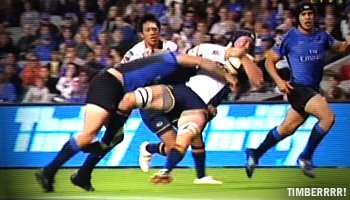Rugby Collisions
When
Runner and Tackler Meet
When our runner is moving in the open field, he has a momentum
of 960 kg-m/s. To stop him -- change his momentum -- a tackler must
apply an impulse in the opposite direction. Impulse
is the product of the applied force and the time over which that force
is applied. Because impulse is a product like momentum, the same
impulse can be applied if one varies either the force of impact or the
time of contact. If a defense man wanted to tackle our runner,
he would have to apply an impulse of 960 kg-m/s. If the tackle occurred
in 0.5 s, the force applied would be:
- F = impulse/t = (960 kg-m/s)/(0.5 s) = 1921
N = 423 lb
Alternatively, if the
defensive man increased the time in contact with the runner, he
could use less force to stop him.
In any collision or tackle in
which there is no force other than that created by the collision
itself, the total momentum of those involved must be the same before
and after the collision -- this is the conservation of momentum.
Let's look at three cases:

- The runner has the same momentum
as the
tackler.
- The runner has more momentum
than the tackler.
- The runner has less momentum
than the tackler.
For the discussion, we will
consider an elastic
collision, in which the
players do not remain in contact after they collide.
- If the ball carrier and tackler have equal momentum, the
forward momentum of the ball carrier is matched by the backward
momentum of the tackler. The motion of the two will stop at the point
of contact.
- If the ball carrier has more momentum than the tackler, he
will knock the tackler back with a momentum that is equal to the
difference between the two players, and will likely break the tackle.
After breaking the tackle, the runner will accelerate.
- If the runner has less momentum than the tackler, he
will be knocked backwards with a momentum equal to the difference
between the two players.
In many instances, tacklers
try to hold on to the ball carrier, and the two may travel together. In
these inelastic
collisions, the general
reactions would be the same as those above; however, in cases 2 and 3,
the speeds at which the combined players would move forward or backward
would be reduced. This reduction in speed is due to the fact that the
difference in momentum is now distributed over the combined mass of the
two players, instead of the mass of the one player with the lesser
momentum.


